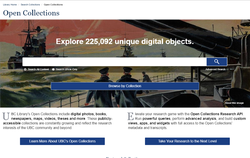Library:Open Collections
| UBC Open Collections Maintained by UBC Library | |
|---|---|

| |
| Summary | |
| UBC Library's Open Collections include digital photos, books, newspapers, maps, videos, theses and more. These publicly-accessible collections are constantly growing and reflect the research interests of the UBC community and beyond. | |
| Data Sources | |
| Help and Documentation | |
UBC Library's Open Collections include digital photos, books, newspapers, maps, videos, theses and more. These publicly-accessible collections are constantly growing and reflect the research interests of the UBC community and beyond.
Holdings
Repositories
Open Collections contains items from the following sources[1]:
- cIRcle: University of British Columbia's digital repository for research and teaching materials created by the UBC community and its partners.
- Rare books and Special Collections: UBC Library acquires archival materials which document the economic, political, cultural, labour, and literary history of British Columbia and Canada as well as the history of the University. Archival material which is born digital or digitized is included in Open Collections.
- Digital Collections: UBC Library's Digital Collections consist of locally-created digital collections developed and maintained by the Library. Collectively they document a diverse range of people and places, activities and events, and serve as a resource for students, historians, genealogists, and other researchers. Most of this content has been digitized from material held at the Library.
Adding Materials to Open Collections
Because of its robust set of features centered on organizing, finding, and sharing information, adding your materials to Open Collections is a valuable way for members of the UBC community to share resources as widely as possible.
Students, faculty, and other UBC-affiliated entities who would like to have materials related to their research or studies (theses, dissertations, conference posters, etc...) listed in Open Collections can contact cIRcle for information on how to have their materials added to UBC's institutional repository.
To add non-digital materials to Open Collections that are significant to UBC's history, mission, or research endeavors (e.g. letters, photographs, printed materials, and other physical objects), contact UBC's Digitization Centre to learn about what materials can be digitized and what resources are available.
Features
Open Access
As the name suggests, Open Collections is free to use for anyone with an internet connection, no login credentials needed. Open Collections allows anyone to find and view UBC's digitized materials on the platform itself through the Document Viewer, and download or share items (subject to each item's individual copyright status).
Search Functionality
Open Collections enables users to search through UBC's digitized materials either by using the text search bar, or by browsing through its collections directly. Text search results can be further filtered by an object's type, creator, subject, and more.
API
Open Collections features an Application Program Interface (API), which allows users to run queries, perform analysis, and build custom tools to suit their needs using the materials and information within Open Collections, without having to use the web interface. Open Collections' API has supported Digital Humanities initiatives on campus through a number of projects involving mapping documents to physical locations across the province, visualizing metadata in meaningful ways, and creating timelines to help situate documents in the broader historical context.
To access API functionality, users must register with a valid email address to receive an API key.[2] To facilitate API usage, users can use the API Portal within Open Collections to find documentation and build queries.
Document Viewer
To help users make the most of their experience, Open Collections' Document Viewer has robust functionality that allows users to, among other things:
- View high-resolution scans of documents
- Search for text within documents
- Save part or all of a document to their computers, or share online to social media platforms
- Automatically generate a citation in a number of commonly-used formats
- Comment on objects
- See statistics that show where an object has been viewed or downloaded around the world
For more information and to learn how to use the Document viewer, see the Help section.
Finding Help
Documentation
- Open Collections/Help: Open Collections documentation has been aggregated into a single page. Here, you can find information on how to use Open Collections in plain English, as well as links to assorted technical documentation.
Other Guides
- Primary Sources for K-12 Educators: This guide is for K-12 educators seeking to use digital primary sources in their classrooms, and includes how-to guides and instructional videos for Open Collections geared specifically toward K-12 teachers
Points of Contact
- Bronwen Sprout: Head, Digital Programs and Services, Digital Initiatives
- Katherine Kalsbeek: Head, Rare Books & Special Collections
- Tara Stephens-Kyte: cIRcle Digital Repository Librarian
